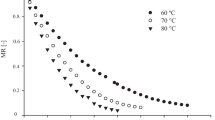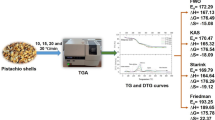Abstract
In this paper, the 5-hydroxymethylfurfural (HMF) contents of the acacia honeys after heat treatment were determined by HPLC; the kinetics of HMF formation was also investigated. The HMF content of acacia honey was 0.38±0.01mg/kg, but rapidly increased to the maximum of 18,320.07±14.29 mg/kg at 190°C and decreased to 1,180.24±6.54 mg/kg at 230°C after heating. The HMF content increased gradually in honey samples heated in 12 h at the temperature of 80, 100, and 120°C. The apparent frequency constant was k f =3.91×1025/h, and the apparent activation energy was E a=173.10 kJ/mol. The HMF content in the acacia honey was related to honey composition, heating temperature, and time, and the HMF formation could also be related to the initial honey pH.
Similar content being viewed by others
References
Kahraman T, Buyukunal SK, Vural A, Altunatmaz SS. Physicochemical properties in honey from different regions of Turkey. Food Chem. 123: 41–44 (2010)
Ojeda De Rodríguez G, Sulbarán De Ferrer B, Ferrer A, Rodríguez B. Characterization of honey produced in Venezuela. Food Chem. 84: 499–502 (2004)
Mendes E, Brojo Proença E, Ferreira IMPLVO, Ferreira MA. Quality evaluation of Portuguese honey. Carbohyd. Polym. 37: 219–223 (1998)
Ouchemoukh S, Louaileche H, Schweitzer P. Physicochemical characteristics and pollen spectrum of some Algerian honeys. Food Control 18: 52–58 (2007)
Przyby P, Wilczyñska A. Honey as an environmental marker. Food Chem. 74: 289–291 (2001)
Singh N, Bath PK. Quality evaluation of different types of Indian honey. Food Chem. 58: 129–133 (1997)
Yilmaz H, Yavuz O. Content of some trace metals in honey from south-eastern Anatolia. Food Chem. 65: 475–476 (1999)
Fallico B, Zappalà M, Arena E, Verzera A. Effects of conditioning on HMF content in unifloral honeys. Food Chem. 85: 305–313 (2004)
Kroh LW. Caramelisation in food and beverages. Food Chem. 51: 373–379 (1994)
Lee HS, Nagy S. Relative reactivities of sugars in the formation of 5-hydroxymethylfurfural in sugar-catalyst model systems. J. Food Process. Preserv. 14: 171–178 (1990)
Gökmen V, Açar ÖC, Köksel H, Acar J. Effects of dough formula and baking conditions on acrylamide and hydroxymethylfurfural formation in cookies. Food Chem. 104: 1136–1142 (2007)
Capuano E, Fogliano V. Acrylamide and 5-hydroxymethylfurfural (HMF): A review on metabolism, toxicity, occurrence in food, and mitigation strategies. LWT-Food Sci. Technol. 44: 793–810 (2011)
Nozal MJ, Bernal JL, Toribio L, Jiménez JJ, Martín MT. Highperformance liquid chromatographic determination of methyl anthranilate, hydroxymethylfurfural, and related compounds in honey. J. Chromatogr. A 917: 95–103 (2001)
Teixidó E, Moyano E, Santos FJ, Galceran MT. Liquid chromatography multi-stage mass spectrometry for the analysis of 5-hydroxymethylfurfural in foods. J. Chromatogr. A 1185: 102–108 (2008)
Chen L, Huang H, Liu W, Peng N, Huang X. Kinetics of the 5-hydroxymethylfurfural formation reaction in Chinese rice wine. J. Agr. Food Chem. 58: 3507–3511 (2010)
Garza S, Ibarz A, Pagán J, Giner J. Non-enzymatic browning in peach puree during heating. Food Res. Int. 32: 335–343 (1999)
Ajlouni S, Sujirapinylkul P. Hydroxymethylfurfuraldehyde and amylase contents in Australian honey. Food Chem. 119: 1000–1005 (2010)
Gidamis AB, Chove BE, Shayo NB, Nnko SA, Bangu NT. Quality evaluation of honey harvested from selected areas in Tanzania with special emphasis on hydroxymethylfurfural (HMF) levels. Plant Food. Hum. Nutr. 59: 129–132 (2004)
Joshi SR, Pechhacker H, Willam A, von Der Ohe W. Physicochemical characteristics of Apis dorsata, A. cerana, and A. mellifera honey from Chitwan district, central Nepal. Apidologie 31: 367–375 (2000)
Malika N, Mohamed F, Chakib EA. Microbiological and physicochemical properties of Moroccan honey. Int. J. Agric. Biol. 7: 773–776 (2005)
Bogdanov S, Ruoff K, Oddo PL. Physico-chemical methods for the characterisation of unifloral honeys: A review. Apidologie 35: S4–S17 (2004)
Terrab A, Díez MJ, Heredia FJ. Palynological, physico-chemical, and color characterization of Moroccan honeys: I. River red gum (Eucalyptus camaldulensis Dehnh) honey. Int. J. Food Sci. Tech. 38: 379–386 (2003)
Terrab A, Recamales AF, Hernanz D, Heredia FJ. Characterisation of Spanish thyme honeys by their physicochemical characteristics and mineral contents. Food Chem. 88: 537–542 (2004)
Girisuta B, Janssen LPBM, Heeres HJ. Green chemicals: A kinetic study on the conversion of glucose to levulinic acid. Chem. Eng. Res. Des. 84: 339–349 (2006)
Girisuta B, Janssen LPBM, Heeres HJ. A kinetic study on the decomposition of 5-hydroxymethylfurfural into levulinic acid. Green Chem. 8: 701–709 (2006)
Woo KS, Hwang IG, Kim HY, Jang KI, Lee J, Kang TS, Jeong HS. Thermal degradation characteristics and antioxidant activity of fructose solution with heating temperature and time. J. Med. Food. 14: 167–172 (2011)
Gonzales AP, Burin L, Buera MDP. Color changes during storage of honeys in relation to their composition and initial color. Food Res. Int. 32: 185–191 (1999)
Morales FJ, Van Boekel MAJS. A study on advanced Maillard reaction in heated casein/sugar solutions: Color formation. Int. Dairy J. 8: 907–915 (1998)
Cotte JF, Casabianca H, Chardon S, Lheritier J, Grenier-Loustalot MF. Application of carbohydrate analysis to verify honey authenticity. J. Chromatogr. A 1021: 145–155 (2003)
Kamal MA, Klein P. Determination of sugars in honey by liquid chromatography. Saudi J. Biol. Sci. 18: 17–21 (2011)
Mateo R, Bosch-Reig F. Classification of Spanish unifloral honeys by discriminant analysis of electrical conductivity, color, water content, sugars, and pH. J. Agr. Food Chem. 46: 393–400 (1998)
Anklam E. A review of the analytical methods to determine the geographical and botanical origin of honey. Food Chem. 63: 549–562 (1998)
Redding AP, Wang Z, Keshwani DR, Cheng JJ. High temperature dilute acid pretreatment of coastal Bermuda grass for enzymatic hydrolysis. Bioresource Technol. 102: 1415–1424 (2011)
Author information
Authors and Affiliations
Corresponding author
Rights and permissions
About this article
Cite this article
Zhang, Y., Song, Y., Zhou, T. et al. Kinetics of 5-hydroxymethylfurfural formation in chinese acacia honey during heat treatment. Food Sci Biotechnol 21, 1627–1632 (2012). https://doi.org/10.1007/s10068-012-0216-9
Received:
Revised:
Accepted:
Published:
Issue Date:
DOI: https://doi.org/10.1007/s10068-012-0216-9




